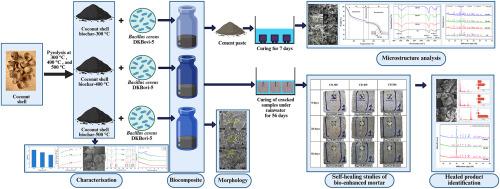椰壳生物炭-蜡样芽孢杆菌DKBovi-5基生物复合材料作为水泥砂浆的可持续添加剂:热解温度对表征、强度、水化和愈合的影响
IF 5.8
2区 化学
Q2 CHEMISTRY, MULTIDISCIPLINARY
引用次数: 0
摘要
虽然生物炭-细菌复合材料已经在胶凝材料中进行了自修复的探索,但热解温度对微生物相容性和修复性能的影响研究还不够。本研究通过研究热解温度如何影响椰子壳生物炭的物理化学性质及其作为砂浆中微生物载体的有效性来解决这一空白。对300°C、400°C和500°C制备的生物炭进行了表征,并将蜡样芽孢杆菌DKBovi-5固定在其上形成生物复合材料。将生物复合材料掺入砂浆中,以评估力学、微观结构和裂纹愈合性能。表征表明,在500°C时,生物炭的结晶度增强,FESEM证实了初级和次级孔隙的发育,通过ICP-MS观察到热富集导致微量营养素浓度增加。在300℃和500℃温度下,抗压强度恢复从80.21%增加到91.23%。利用Bhatty的方法进行的TGA分析表明,水化程度从61.65%增加到65.33%。XRD数据的Rietveld细化显示方解石含量从24%上升到51%。FESEM成像证实了生物炭孔隙中水化产物的沉积。修复评价显示,300℃和500℃生物复合材料砂浆的裂缝闭合率分别为0.762 mm和0.920 mm,对应的愈合面积分别为92.49%和100%。通过FESEM-EDS和XRD分析,证实复合材料的愈合产物为方解石。在500°C下优化热解得到了具有优异微生物愈合性能的生物复合材料,确立了其作为生物砂浆自愈合添加剂的适用性。本文章由计算机程序翻译,如有差异,请以英文原文为准。

Coconut shell biochar–Bacillus cereus DKBovi-5 based biocomposite as a sustainable additive for cement mortar: Effect of pyrolysis temperature on characterization, strength, hydration, and healing
Although biochar–bacteria composites have been explored for self-healing in cementitious materials, the influence of pyrolysis temperature on microbial compatibility and healing performance has been insufficiently investigated. This study addresses this gap by examining how pyrolysis temperature affects the physicochemical properties of coconut shell biochar and its effectiveness as a microbial carrier in mortar. Biochar produced at 300 °C, 400 °C, and 500 °C was characterized, and Bacillus cereus DKBovi-5 was immobilized onto it to form biocomposites. The biocomposites were incorporated into mortar to evaluate mechanical, microstructural, and crack healing performances. Characterization of biochar showed enhanced crystallinity at 500 °C as indicated by XRD, development of primary and secondary pores confirmed by FESEM, and increased micronutrient concentrations due to thermal enrichment observed through ICP-MS. Compressive strength restoration increased from 80.21 % to 91.23 % between 300 °C and 500 °C temperatures. TGA analysis, interpreted using Bhatty's method, indicated an increase in the degree of hydration from 61.65 % to 65.33 %. Rietveld refinement of XRD data revealed a rise in calcite content from 24 % to 51 %. FESEM imaging confirmed the deposition of hydration products within the biochar pores. Healing evaluation showed closure of cracks up to 0.762 mm and 0.920 mm in mortars with 300 °C and 500 °C biocomposites, respectively, corresponding to healed areas of 92.49 % and 100 %. The healed products in all biocomposites were confirmed as calcite through FESEM-EDS and XRD analyses. Optimized pyrolysis at 500 °C yielded a biocomposite with superior microbial healing performance, establishing its suitability as a self-healing admixture in bio-mortar applications.
求助全文
通过发布文献求助,成功后即可免费获取论文全文。
去求助
来源期刊

Sustainable Chemistry and Pharmacy
Environmental Science-Pollution
CiteScore
8.20
自引率
6.70%
发文量
274
审稿时长
37 days
期刊介绍:
Sustainable Chemistry and Pharmacy publishes research that is related to chemistry, pharmacy and sustainability science in a forward oriented manner. It provides a unique forum for the publication of innovative research on the intersection and overlap of chemistry and pharmacy on the one hand and sustainability on the other hand. This includes contributions related to increasing sustainability of chemistry and pharmaceutical science and industries itself as well as their products in relation to the contribution of these to sustainability itself. As an interdisciplinary and transdisciplinary journal it addresses all sustainability related issues along the life cycle of chemical and pharmaceutical products form resource related topics until the end of life of products. This includes not only natural science based approaches and issues but also from humanities, social science and economics as far as they are dealing with sustainability related to chemistry and pharmacy. Sustainable Chemistry and Pharmacy aims at bridging between disciplines as well as developing and developed countries.
 求助内容:
求助内容: 应助结果提醒方式:
应助结果提醒方式:


